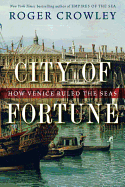
Roger Crowley (Empires of the Sea) returns to the medieval and early modern Mediterranean in City of Fortune, using three defining moments to tell the story of Venice's development from a "smattering of low-lying muddy islets set in a malarial lagoon" to the greatest power in the region: the city-state's pivotal role in the Fourth Crusade and the sacking of Constantinople in 1204; the city's bloody rivalry with Genoa for control of the East-West trade; and its desperate defense against the Ottoman Empire's expansion into the Mediterranean in the 15th century.
As in his earlier books, Crowley's fast-paced narrative style and vivid character sketches strike a nice balance between the big picture and the important detail. He tells the story using a variety of voices. In addition to accounts by Venetian doges, merchants and city officials, he uses those written by--often hostile--outsiders, including the poet Petrarch, Pope Innocent III, Norman crusaders and Cretan rebels. Trade is the theme that ties all these stories together. With no natural resources, no agriculture and a small population, Venice depended entirely on trade for its survival. Its relationships first with Byzantium and later with the Islamic world were both the foundation of its prosperity and a source of contention with the rest of Christendom. Control of the western end of the overland trade caravans was the key to Venice's success as "Europe's first full-blown colonial adventure." Crowley ends with the event that would bring Venetian maritime dominance to a close: the news that Portugal had found a sea route to India, rendering the Venetian empire suddenly obsolete. --Pamela Toler, blogging at History in the Margins

